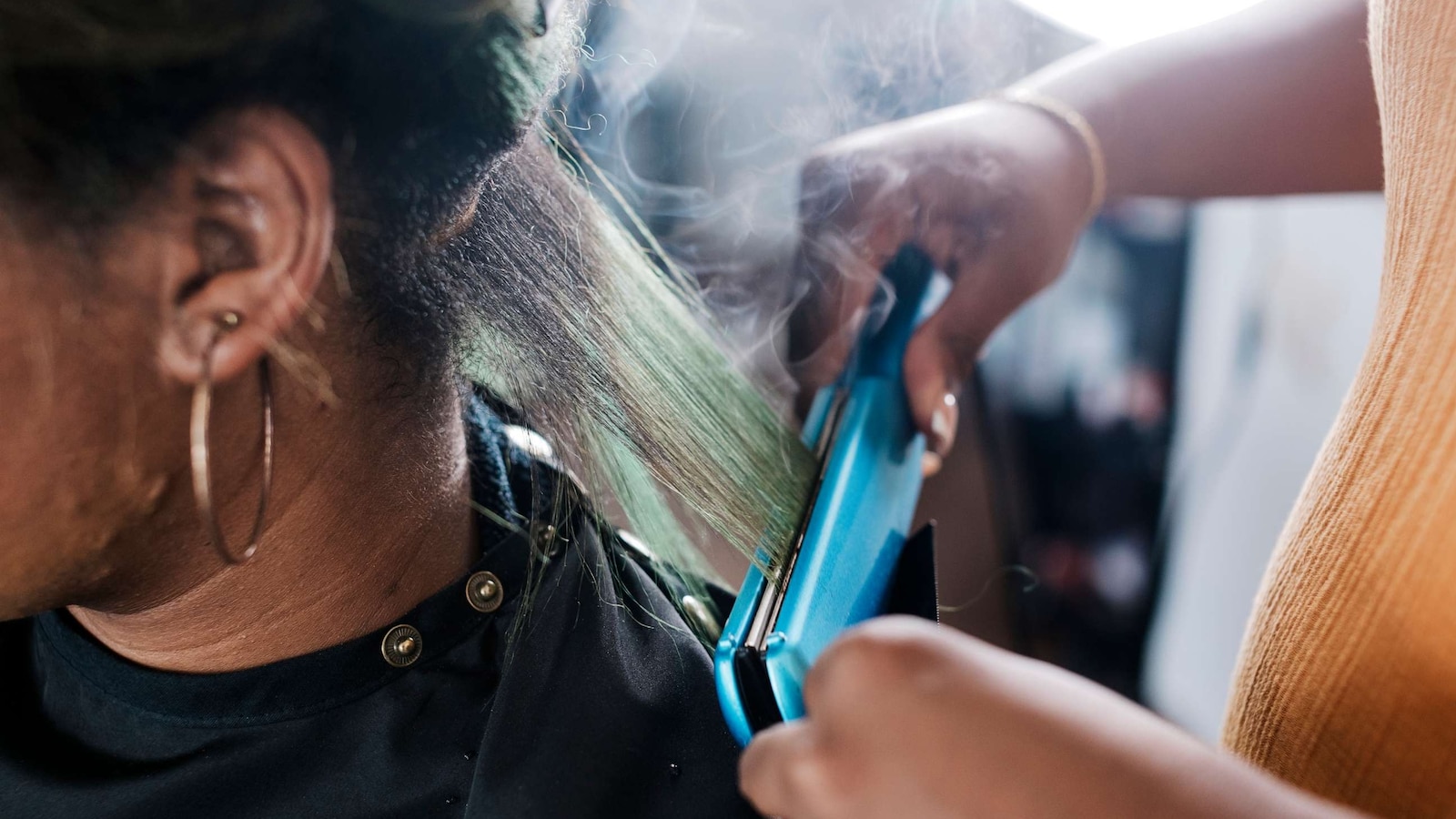Are Synthetic Hair Braids Harming Black Women's Health?

Table of Contents
Traction Alopecia and Hair Loss from Synthetic Braids
Tightly braided synthetic hair can cause significant tension on the scalp, leading to traction alopecia – a type of hair loss caused by excessive pulling. This is a serious concern, especially for Black women who frequently wear braids.
- Mechanics of Traction Alopecia: The constant pulling and tension on hair follicles from tight braids disrupt the hair growth cycle. This can weaken the follicles, leading to thinning hair and eventual hair loss.
- Visible Symptoms: Traction alopecia often manifests as thinning hair, a receding hairline, or bald patches, particularly along the hairline or temples.
- Potential for Permanent Hair Loss: If left untreated, traction alopecia can result in permanent hair loss. The damage to the hair follicles may be irreversible.
- Prevalence: Studies indicate a high prevalence of traction alopecia among Black women, highlighting the importance of understanding and mitigating the risks associated with tight braiding techniques.
Preventing Hair Loss from Synthetic Braids
Fortunately, there are steps you can take to significantly reduce your risk of traction alopecia:
- Choose a Skilled Stylist: Select a stylist experienced in protective styling who understands the importance of avoiding excessive tension on the scalp.
- Avoid Excessively Tight Braids: Loose braids put less stress on hair follicles. If you feel any pulling or discomfort, speak up immediately.
- Take Breaks: Give your scalp regular breaks from braids. Allow your hair to breathe and recover between installations.
- Gentle Hair Products: Use gentle shampoos, conditioners, and other hair products that won't further damage your hair.
- Consider Looser Braiding Styles: Explore less tension-inducing styles like cornrows or box braids that are not overly tight.
Scalp Infections and Hygiene Concerns with Synthetic Hair Braids
Synthetic hair can trap sweat, dirt, and oil, creating a perfect breeding ground for bacteria and fungi. This can lead to various scalp infections.
- Common Scalp Infections: Folliculitis (inflammation of hair follicles), tinea capitis (ringworm), and other fungal infections are common concerns.
- Symptoms: Symptoms can include itching, redness, inflammation, pus-filled bumps, and flaking skin.
- Importance of Scalp Hygiene: Maintaining excellent scalp hygiene is crucial to prevent infections.
- Preventative Measures: Regular washing and cleansing of the scalp are essential.
Maintaining Scalp Hygiene with Synthetic Braids
Maintaining scalp health while wearing synthetic braids requires diligence:
- Washing Frequency: Wash your scalp and hair regularly, ideally every 1-2 weeks, depending on your activity level and hair type.
- Cleansing Techniques: Use a gentle shampoo and carefully cleanse the scalp beneath the braids. You might need to use a cleansing solution to reach the scalp effectively.
- Air Drying: Air drying is preferable to heat drying, which can further dry out the scalp.
- Product Buildup: Be mindful of product buildup, which can clog follicles and contribute to infections.
Allergic Reactions and Chemical Exposure from Synthetic Hair Braids
Synthetic hair may contain chemicals that can cause allergic reactions in sensitive individuals. Dyes, preservatives, and other treatments used in manufacturing can be irritants.
- Potential Allergens: Formaldehyde, dyes, and other chemicals are potential allergens found in some synthetic hair.
- Symptoms of Allergic Reactions: Itching, rash, inflammation, and contact dermatitis are common symptoms of an allergic reaction.
- Choosing Hypoallergenic Hair: Look for synthetic hair explicitly labeled as hypoallergenic.
- Patch Testing: Before using a new type of synthetic hair, perform a patch test on a small area of skin to check for allergic reactions.
Choosing Safe Synthetic Hair Braids
Making informed choices when purchasing synthetic hair is crucial:
- Reputable Brands: Opt for reputable brands with transparent ingredient lists that clearly state what the hair is made of.
- Certifications: Look for certifications indicating low chemical content or environmentally friendly manufacturing processes.
- Manufacturing Process: Inquire about the manufacturing process if possible; this can help you gauge the potential for chemical exposure.
Conclusion
This article has highlighted the potential health risks associated with synthetic hair braids, including traction alopecia, scalp infections, and allergic reactions. While synthetic hair braids can be a beautiful and versatile styling option, it's crucial to prioritize scalp health and take preventative measures. By understanding the potential risks of synthetic hair braids and practicing good hygiene, you can enjoy the beauty of synthetic hair braids while minimizing the potential harm to your health. Remember to research and choose reputable brands, opt for less damaging styling techniques, and prioritize regular scalp care. Make informed choices about your synthetic hair braids and protect your well-being!

Featured Posts
-
 Ecb Baskani Lagarde Artan Kueresel Ticaret Gerilimleri Ve Enflasyonun Etkileri
May 27, 2025
Ecb Baskani Lagarde Artan Kueresel Ticaret Gerilimleri Ve Enflasyonun Etkileri
May 27, 2025 -
 La Caf Prend Position Sur Le Sahara Occidental Les Details
May 27, 2025
La Caf Prend Position Sur Le Sahara Occidental Les Details
May 27, 2025 -
 The Complete Guide To Ringo And Friends Cbs Country Music Event At The Ryman
May 27, 2025
The Complete Guide To Ringo And Friends Cbs Country Music Event At The Ryman
May 27, 2025 -
 How To Stream 1923 Season 2 Episode 5 Tonight Without Paying
May 27, 2025
How To Stream 1923 Season 2 Episode 5 Tonight Without Paying
May 27, 2025 -
 How Ridley Scott Reshaped The Alien Franchise 13 Years Ago
May 27, 2025
How Ridley Scott Reshaped The Alien Franchise 13 Years Ago
May 27, 2025
Latest Posts
-
 Nasjonaldagen I Moss 17 Mai Program Aktiviteter Og Mer
May 29, 2025
Nasjonaldagen I Moss 17 Mai Program Aktiviteter Og Mer
May 29, 2025 -
 Mai Arrangementer I Moss Alt Du Trenger A Vite
May 29, 2025
Mai Arrangementer I Moss Alt Du Trenger A Vite
May 29, 2025 -
 Festspill I Moss 17 Mai Fullstendig Program Og Overaskelse
May 29, 2025
Festspill I Moss 17 Mai Fullstendig Program Og Overaskelse
May 29, 2025 -
 Mai Moss Feir Nasjonaldagen Med Oss
May 29, 2025
Mai Moss Feir Nasjonaldagen Med Oss
May 29, 2025 -
 Mai I Moss Programmet For Nasjonaldagen Er Klart
May 29, 2025
Mai I Moss Programmet For Nasjonaldagen Er Klart
May 29, 2025
